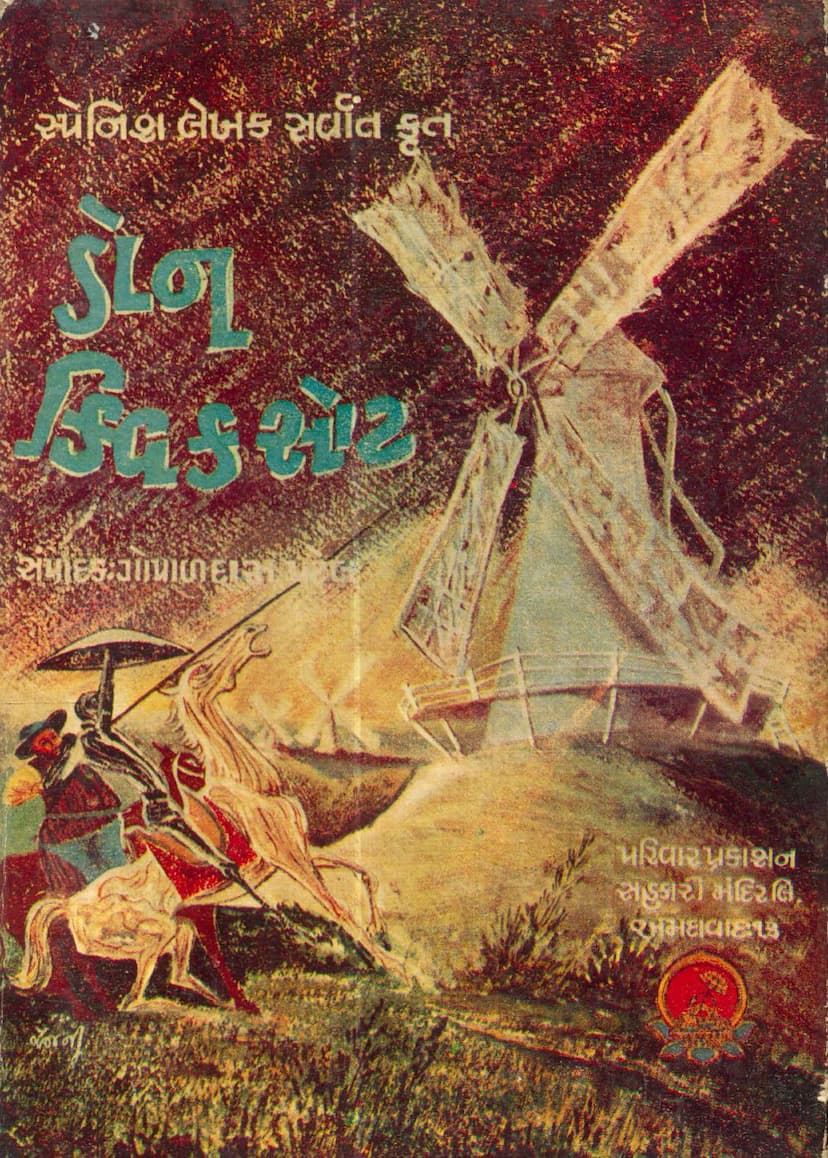Don Quicksot
Added to library: September 1, 2025

Summary
Based on the provided Gujarati text, here's a comprehensive summary of "Don Quixote" as presented in this Jain publication:
Book Title: Don Quixote (ડૉન કિવક્સોટ) Author: Miguel de Cervantes Saavedra (મિગુએલ દ સર્વાંત સાવેદ્રા) Translator/Editor: Gopaldas Jivabhai Patel (ગેાપાળદાસ જીવાભાઈ પટેલ) Publisher: Parivar Prakashan Sahkari Mandir Ltd. (પરિવાર પ્રકાશન સહકારી મંદિર લિ) Publication Year: April, 1966 Language: Gujarati
Overview and Significance:
The publication introduces "Don Quixote" as a seminal work of "love-chivalry' (પ્રેમશૌર્ય) that is also a unique comedy (એક અનોખી નર્મકથા). The publisher emphasizes its immense global popularity, stating it has been translated into 55 languages and published in over two thousand editions. A striking claim from the Spanish people is quoted: that "Don Quixote," after the Bible, is the second most widely read book in the world. The Gujarati translation is considered a valuable gift to Gujarati literature, following in the footsteps of other classics like "Les Misérables," "A Tale of Two Cities," and "The Three Musketeers," previously published by the same organization.
The Author and His Life:
The text provides a detailed biographical sketch of Miguel de Cervantes. It highlights his humble beginnings, his career as a brave and selfless soldier, and how he conceived the idea for "Don Quixote" while imprisoned. His life was marked by hardship, including poverty, military service, and five years of captivity in Algeria, which instilled in him great tolerance and resilience. Despite these struggles, he maintained a hopeful and cheerful disposition. His literary career began with pastoral tales and plays, but it was "Don Quixote," published in two parts in 1605 and 1615, that brought him immense fame, spreading his renown across Europe. The book's enduring appeal, even after 360 years, is attributed to its unique humor, its ability to evoke both laughter and pathos, and its profound insights into life's truths, presented with a philosophical flair.
Thematic Core of the Novel:
The book is described as a humorous narrative (નર્મકથા) based on the medieval tradition of "knight-adventurers" (નાઈટ-સાહસવીરો). Don Quixote, a gentleman of La Mancha, is depicted as a dreamer and an idealist who, after reading too many chivalric romances, loses his grip on reality. He believes himself to be a knight-errant, ready to right wrongs, protect the weak, and achieve glory in the name of his lady, Dulcinea del Toboso.
Don Quixote's Transformation:
The initial chapters detail how the protagonist, an elderly gentleman named Alonso Quixano (named Quixada or Quixada in the text, with a humorous note on the etymology), transforms himself into "Don Quixote de la Mancha." This transformation is driven by his obsessive reading of chivalric novels. His mind becomes so saturated with these tales that he begins to perceive the ordinary world as if it were the setting for his own chivalric adventures. He sees windmills as giants, inns as castles, and ordinary peasant girls as princesses.
Key Elements of the Narrative:
- The Character of Don Quixote: He is portrayed as a valiant but delusional knight who embarks on absurd quests, often mistaking reality for fantasy. His idealism and dedication to his chosen code, despite the often comical and disastrous outcomes, are central to the story.
- Sancho Panza: Don Quixote's squire, Sancho Panza, is depicted as a simple, pragmatic, and often greedy peasant. He serves as a foil to Don Quixote's idealism, constantly grounding the knight in reality, albeit in his own humorous and earthy way. Despite his initial motivations of personal gain (like becoming a governor of an island), Sancho develops a deep loyalty to his master.
- The Quests and Adventures: The novel follows Don Quixote and Sancho Panza as they travel through Spain, encountering various characters and situations. These adventures are characterized by Don Quixote's misinterpretations of reality, leading to comical mishaps and often unintended consequences. The publication highlights key episodes like:
- The "construction" of the "future knight" and his departure.
- The "dubbing ceremony" where Don Quixote is knighted by an innkeeper.
- His "great journey."
- The famous battle with the windmills (mistaken for giants).
- His encounter with Biscayans.
- His "love-penance" and other chivalric deeds.
- The freeing of the galley slaves.
- The subsequent adventures and the eventual disillusionment.
- Humor and Philosophy: The book is noted for its profound humor, which arises from the contrast between Don Quixote's noble ideals and the mundane reality he faces. Beneath the humor, however, lies a philosophical exploration of truth, illusion, idealism, and the human condition. The text emphasizes the author's skill in creating both laughter and sorrow, and how the core message of the story resonates deeply.
- Social Commentary: The novel is also seen as a commentary on the outdated ideals of chivalry and a critique of the popular romances of Cervantes' time.
The Gujarati Translation:
Gopaldas Jivabhai Patel's "extensive abridgment" (વિસ્તૃત સંક્ષેપ) is presented. The publication acknowledges the difficulty of translating the unique humor of the original into Gujarati. The preface and introductory notes by Gopaldas Patel and guest writer Maganbhai Desai ("Satyagraha" weekly editor) further elaborate on the book's importance and appeal. Maganbhai Desai's piece, in particular, delves into the nature of humor, the universality of Don Quixote's character (seeing him and Sancho as two aspects of every human being), and compares the story's impact to that of "Bhadrambhadra" in Gujarati literature, highlighting the nuanced portrayal of idealism and societal critique.
Overall Message:
"Don Quixote" is presented as an "autobiographical mirror" (આત્મદર્શક અરીસા) and a "heavy loadstone" (એક ભારે પાર). It is a timeless classic that offers both entertainment and profound wisdom, encouraging readers to reflect on their own ideals and the nature of reality. The Gujarati edition aims to make this world literature accessible to Gujarati readers, fostering an appreciation for its rich heritage of humor, pathos, and philosophical depth. The book's illustrations are also noted, contributing to its appeal.